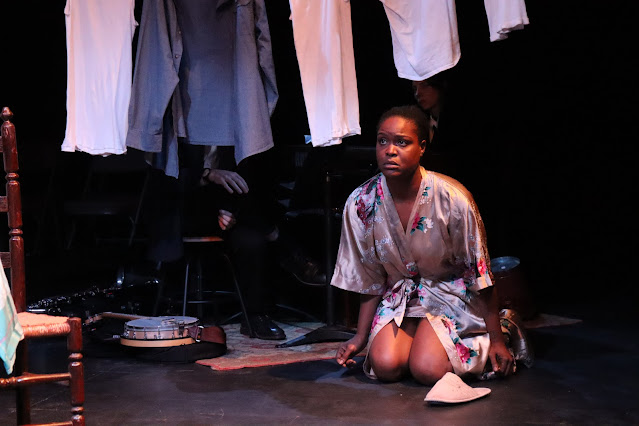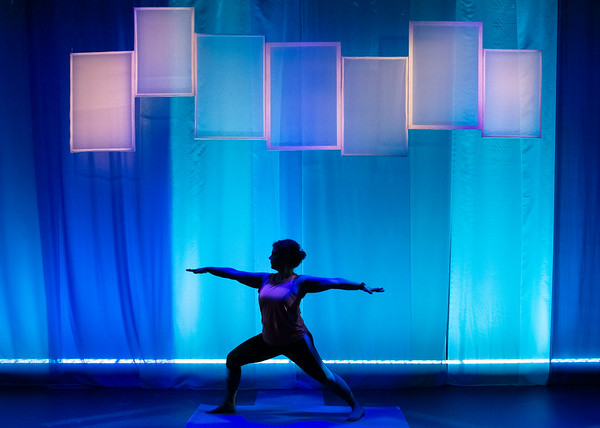Review: Big Issues, Tiny Set in Amina Henry's "Rent Party"
Rent Party
Written by Amina Henry
Directed by Gretchen Van Lente
Presented by Drama of Works at The Tank
316 W. 36th St., Manhattan, NYC
July 12-21, 2019
 |
| Ashley Winkfield and Christian Roberson. Photo credit: Kacey Anisa Stamats. |
People associate New York with many things. High rents top anyone’s list. Exorbitantly high rents in the city are a relatively new thing, though. One could find an apartment in many neighborhoods for just a few hundred, or even double digits, a month for most of the twentieth century. However, tenants’ relationships with landlords have always been sticky in the city—especially in Harlem. African Americans have faced more challenges regarding rent in NYC given that they were allowed (socially and for a time legally) to live only in a few areas of the city, and landlords took advantage of that. Enter the rent party. The burst of artistic activity in Harlem in the 1920s including poetry, fiction, music, drama, and visual art has given rise to all sorts of theories of origins. One origin story is directly linked to rent parties. Sometimes called “boogies,” these parties originated in Harlem and served both to help the host make rent with a hat passed around for partiers to contribute and to act as a platform for budding jazz and blues musicians. Set within the context of the Great Migration of African Americans from the South to the industrial cities of the North, Amina Henry’s Rent Party is a commentary on the tension between hope and facing reality when one’s prospects for the future are clearly limited. It is a coming-of-age story of three kids who are too young to come of age but must do so to survive the challenges of being Black in New York in the 1920s.
Rent Party follows one day in the life of three kids, ages 7 to 11, and their attempt to throw a party to make next month’s rent to avoid eviction. Jenny (AnJu Hyppolite), Rose (Maya Posey), and Ricky (Christian Roberson) are on a mission, and the play follows their attempts to find ice, find a performer, and set up for the party. What they do along the way is discover their dreams for their futures might have limits. As they go from place to place with their to-do list they talk about what they want to be when they grow up—a nurse, a teacher, even president. Ricky gets scolded when he announces, “When I grow up, I’m gonna punch white folks in the nose.” This received a round of laughter from the audience. The play opens with an actual “cool cat” in puppet form who serves as the narrator/emcee/poet. He delivers short, aphoristic interludes between the kids’ scenes that serve as thematic structuring mechanisms for the action that follows: “I love me some Harlem”; “Where do black folks love outside of Harlem?”; “When times are tough, it’s party time.” The puppet, controlled by Roberson, is able to jump all over the set because the stage is tiny. It is a toy set of a Harlem block. The actors use small, paper dolls (cutout pictures of themselves in the spot-on period costumes the actors also wear) and walk them around the set. The metaphor is clear from the start. These are kids trying to figure out heavy issues with toys.
Other characters, such as Mama Tulip, Mr. Lowe, and Mamma Q (all Ashley Winkfield), appear as paper figures in the windows and doors of the toy set, summoning the classic image of the NYC window conversation. The set is quite versatile, as parts open to reveal the inside of apartments and it is even transformed in one scene into the Regency Hotel—a symbol for privilege and the good life. Seeing the set as I walked in, I thought this could go two ways. However, suspension of disbelief happened almost immediately, and I was sold. The stage is more than a gimmick or inventive adaptation to a small space (the stage is quite small). Using a toy set with paper figures and a puppet allows the audience a way into the mind of a child grappling with heavy issues. Throughout their day, the three kids discuss what they want to be in the future. They also discuss the concept of job “benefits” when they go to Carter Jenkins’s hotel where he works as a doorman. They are trying to get Jenkins to play his horn at their party, but he has to work that night at his “benefitted job.” Jenkins tries to explain to them that benefits is an adult topic they shouldn’t worry about. But the kids school him by asking how they are benefits when his job takes money out of his check to pay for them. They are also lectured to about the limits on Black kids by Mamma Q, although sympathetically. The most unsettling moments, delivered with some humor, are when the kids hear police sirens and immediately duck and pretend to be doing something else. The instinctive reaction to the police and the potential for something bad happening as a consequence is the dark shadow over this play.
-Joseph Donica




Comments
Post a Comment